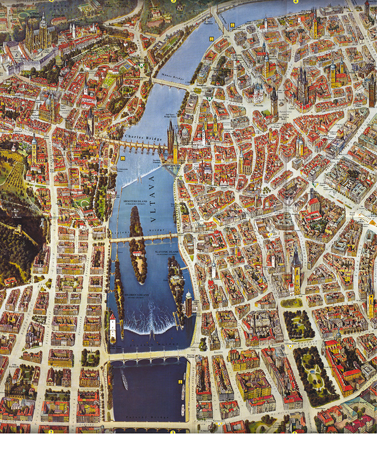Travel & Culture
Czech this out!
Everyone would agree that the right kind of weather really matters when traveling. For people who, like me, are affected by weather conditions and feel that dark clouds can ruin a vacation, planning a trip depending on the climate can be a pain. However, there is one city that rain or shine, storm or clouds, does not fail to retain its elegance and charm, and that is the Czech city of Prague.
Prague transcends the need for movie-like settings such as the right kind of light, or time of year for that matter, to impress an audience of tourists. In fact, I believe that an ideal time to visit Prague would be during a rainy season, as a grey backdrop really highlights the city's architecture.
Prague or Praha, the capital of the modern-day Czech Republic, is remembered by historians as a center of the Holy Roman Empire and the relatively short-lived but grand Austro-Hungarian Empire, and later as one of the backdrops of Nazi conquest. Indeed, with all of this in the city's past, Prague's historic sites have many stories to tell, while its landscape provides an ideal combination of nature and manmade structures, working together to form a beautiful city.
To begin with, the city center of Prague is built around the Vltava River, so this geographical feature adds inherent charm to the city. And looking up, the bright red rooftops of the buildings around the center make candy cane-like patterns to form a breathtaking skyline. But the mystery of Prague lies in its narrow cobbled stone streets and alleyways, which have little hidden shops and cafes scattered about.
After meandering your way through the maze of streets, you should be able to find your way to the Orloj or Astronomical Clock -- a complicated-looking masterpiece any horologist would be proud of. It is claimed that the Prague Orloj is the oldest clock still in working condition. Every hour scores of tourists gather around it to watch animated figures appear from a pair of windows above the clock's dials and rotate to the sounds of ringing bells.

A few steps away from the Astronomical Clock is the Old Town Square, literally a massive square surrounded by overarching buildings. The square is very lively throughout the day, bustling with both locals and tourists. If you're lucky you may be able to catch a performance or two of the folk dancers who frequently set up a stage there.
Just a few meters from the Old Town Square is the old Jewish quarter of the city, Josefov. Now more like a painful reminder of the city's suffering during the Nazi invasion, it is however rich in historical monuments to visit. Two of the most important are the Old New Synagogue and the Jewish Cemetery -- a congestion of gravestones, layered one on top of the other. Another place to visit at Josefov would be the Pinkas Synagogue, which has names of victims of the Holocaust written in memorial across its walls. The sheer number of deaths recorded on the walls makes you understand the magnitude of the events that occurred during the first half of the 20th century.
In this Old Town part of Prague, the most visited site would perhaps be the Charles Bridge, named after Charles IV of the Holy Roman Empire. A very wide pedestrian bridge, it is easily recognized by its two massive towers -- particularly the more recent Gothic-style one with its pyramid-like roof -- and is additionally adorned with numerous statues that commemorate holy personalities and martyrs. The Charles Bridge is crowded throughout the day with tourists, along with street vendors and artists.
On the other side of town, after climbing what seems like an endless number of steps, you come to the Prague Castle standing atop a hill, giving an almost aerial view of the city. The castle is supposedly the largest in the world, covering an area of 70,000 square meters. The most interesting sites I found within the castle were the Vladislav Hall and the St. Vitus Cathedral. The beauty of the Vladislav Hall lies in its simple yet elegant arched ceiling, forming a floral pattern, while St Vitus's beauty lies in the exact opposite: its intricate architecture and complex facades. The St. Vitus Cathedral is built in Gothic style with the typical elements of spiky decorations, pointed towers and details including vicious gargoyles. Nonetheless, what is more overpowering is its utter size. You might have to bend over backward to actually get a full view of the Cathedral's structure, and the same enormity promised by the Cathedral's exterior is visible inside. Huge stained glass windows decorate the interior of the Cathedral, along with the more fascinating tomb of St. John of Nepomuk. A revered martyr drowned in the very river along whose banks Prague is built, St. John's tomb is surrounded by an elaborate assembly of statues in silver, forming one of the main attractions of the Cathedral.
Above are mentioned just a few of the many sites to visit in Prague. The word limit once again prevents me from going on about more of the city's monuments, its attractive city center with a historic network of tramways, entertainment in the form of a marionette version of the opera "Don Giovanni," and so on. I guess you'll just have to make it to Prague to discover for yourself the untold stories of this magnificent city.
